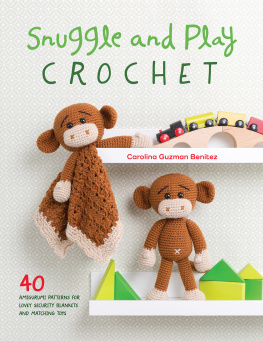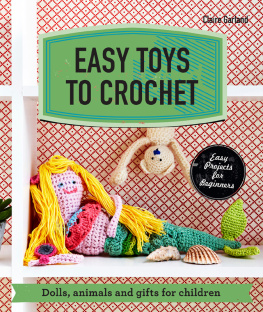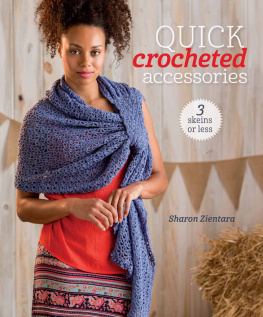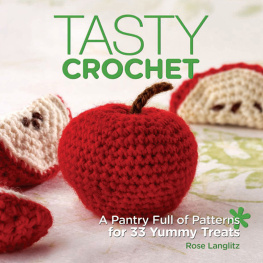With this book, a long-fostered dream of mine has come to life.
I would like to thank my familyfirst and foremost, my husband, for the countless hours he has freed for me so I could concentrate on this project, but also for his motivation and support in so many areas.
Another big thank you goes to my marvelous daughter, who inspired me with countless ideas and has greeted every newly finished piece with radiant eyes. There could be no better motivation imaginable.
Heartfelt thanks also go to my parents, in-laws, and friends, especially to Kathrin, who set me thinking about the whole idea in the first place.
Thank you all for making it possible for me to carry out this undertaking!
Many thanks to the team of EMF Verlag for their confidence in me, especially to Anna Zwicklbauer for the great collaboration and support.
After the birth of her daughter in 2014, Sarah Pawlowski discovered her talent and passion for crocheting. Ever since then, she has been crochetingbesides baby items, clothing, hats, and mostly toys for a play kitchen and play store.
Since 2016, she has been running her blog, www.haekelnfuerdiekinderkueche.word-press.com, where she presents the patterns she designed.
A certified banking specialist by trade, the author is married and lives with her husband and daughter in the Sauerland area of North Rhine-Westphalia in Germany.

Materials
For the crocheted pieces in this book, Ive mostly used the cotton yarn Camilla, by Woll Butt, and in a few cases, Catania, by Schachenmayr. Both yarns have a yardage of 138 yd/125 m per 1.75 oz/50 g cotton and are ideally suited. If these are not available to you, choose a similarly plied, sport-weight cotton yarn of similar yardage/weight and gauge. In some instances, Ive additionally used Brazilia, by Schachenmayr. Should this novelty yarn not be available, suitable alternatives are listed.
I have worked using crochet hooks in sizes 2.5 mm and 3.0 mm. If you do not have these sizes, try a US B-1 (2.25 mm), C-2 (2.75 mm), or D-3 (3.25 mm) hook. Finished size for most of these projects is not critical since they are toys, so a slight variation will not matter. Hook sizes used are individually listed in each pattern. If you want to substitute a different yarn than the one used for the sample, please refer to the ball band of the yarn, and choose the smallest hook size listed.
A significant number of crochet projects require stuffing material. I have used washable polyester fiberfill.
Since all crocheted pieces, with a few exceptions, are intentionally made of yarn and fiber-fill only, they can later be laundered in the washing machine without any problems. I rec ommend placing them into a mesh wash bag in the delicate cycle. As an additional precaution, please always refer to the care instructions on the yarn label.
For closing openings in the crocheted pieces and weaving in ends, Ive used a tapestry needle appropriate for the yarn weight. Additionally needed are scissors, a few stitch markers, the occasional button, and a small amount of craft wire or a few pieces of pipe cleaners (chenille stems).
Brief Overview of Supplies
Most projects will use some or all of the following:
- cotton yarn
- novelty yarn
- crochet hooks, 2.5 mm and/or 3.0 mm
- polyester fiberfill
- tapestry needle
- stitch markers
- scissors
- pipe cleaners or craft wire
- buttons
Typically, crochet patterns will list a gauge that shows how many rows and stitches are in a square of 4 in 4 in/10 cm 10 cm. For the projects in this book, I have intentionally omitted listing a gauge since the exact finished sizes of the items are not crucial. They should just be worked in a similar yarn with comparable yardage/weight and using a crochet hook in a matching size.
Important Tips
For every pattern, please read through all of the instructions before you begin, making sure to use the hook size and either the listed yarn or a similar one, and check whether any additional materials are required.
Crocheting in the Round
When crocheting in the round, each round starts with the indicated number of chains for height adjustment and is joined with a slip stitch into the first stitch of the round at the end. This is especially useful for pieces crocheted in several colors since it creates a clean color transition. Rounds worked in single crochet stitches always start with 1 chain for height adjustment, half double crochet rounds with 2 chains, and double crochet rounds with 3 chains. The correct number of height adjustment chains is always listed in the pattern.
Work is usually not turned when crocheting in the round, except when mentioned otherwise.
Starting with an adjustable magic ring: Form an adjustable magic ring, work the appropriate number of chains for height adjustment, and then work the listed number of stitches into the ring. End the round with a slip stitch into the first stitch.
Starting with a beginning chain: Work the required number of chains. If single crochets are to be worked in the first row after the chain, the last chain worked will be the chain for height adjustment. Crochet the required number of stitches into the chain, working either 2 or 3 stitches into the last chain as stated in the instructions. Now, continue into the unused loops on the other side of the chain. When you have reached the end of the round, join with a slip stitch into the first stitch of the round.
Working an edging around crocheted pieces: Sometimes, you will first crochet in turned rows, and later add an edging around the whole piece, usually in single crochet. In the first edging round, work as follows: After having completed the last row, do not turn your work. Chain 1 for height adjustment; then work the listed number of stitches on every side of the crocheted piece. The first and last stitch of the first and last row are the corner stitches. Into these corner stitches, work either 2 or 3 stitches, depending on the pattern. End the round with a slip stitch into the first stitch.
Working into Front and Back Loops
In some cases, you will work over the same round twice, first working only into one of the 2 loops of the stitch (either the back or front loop), and then into the unused loop of the same stitch during the second pass. These rounds will be marked a or b after the round number.
Spiral Rounds
All patterns in this book are written for joined rounds. If you prefer to crochet in spiral rounds instead, you can skip both the chain for height adjustment at the beginning, and the slip stitch at the end of the round. If doing so, place a piece of contrasting color yarn into the beginning of the round to make counting spiral rounds easier.
Crocheting Back and Forth in Rows
When crocheting in rows, work is turned at the end of each row. Before turning, here, too, the appropriate number of height adjustment chains has to be worked. To reach the required height, this will be 1 chain for single crochet rows, 2 chains for half double crochet rows, and 3 chains for double crochet rows. If, in a few cases, turning without turning chains is necessary, this, too, will be specially mentioned in the pattern.








